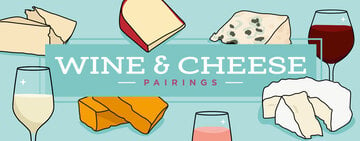
You may have a cheese knife set in your home but may not exactly know what task each one of those knives is made to perform. Just as a chef will use various types of knives in a day to increase their efficiency, each cheese knife type has a purpose to improve the user experience. We prepared a guide and a printable cheese knife resource to help you use the proper knife for the cheeses you are planning to serve.
Shop All Cheese KnivesHow to Choose Cheese Knives Video
Watch the video below to learn more about cheese knives!
Types of Cheese Knives
According to dining etiquette, a cheese knife should not be used on more than one cheese type on your cheese board. Each cheese knife performs a purpose and was built to perform it well. Here is a list of common cheese knives organized from soft cheese knives to hard cheese knives. We'll go through how they are used and some cheeses you can pair them with.

Soft Cheese Knife
A soft cheese knife, also known as an open work blade knife, features holes in the blade to keep soft cheeses from sticking due to the minimal surface area. You can also use the holes to push a piece of cheese off of the knife.
- Features: Sharp edge, holes in blade
- Cheese Hardness: Soft to Semi-Soft
- Ideal Cheeses: Brie, Camembert, Fresh Mozzarella

Cheese Spreader
A cheese spreader, also known as a spatula knife, is made for applying cheese spreads and creamy, spreadable cheeses onto bread and crackers.
- Features: Dull edge, rounded blade
- Cheese Hardness: Soft
- Ideal Cheeses: Robiola, Stracchino, Cream Cheese

Gorgonzola Knife
Similar to a cheese spreader, a gorgonzola cheese knife is made for spreading creamy cheeses. However, the gorgonzola knife has a sharp blade to cut through cheese rinds.
- Features: Rounded blade with one sharp edge
- Cheese Hardness: Soft, Semi-Soft, and Crumbly
- Ideal Cheeses: Gorgonzola, Bleu Cheese

Pronged Cheese Knife
The pronged cheese knife, or forked-tipped spear, is a multipurpose tool that allows you to cut a piece of cheese and then pick it up with the prongs at the end for serving or plating. The narrow blade offers a minimal surface area so soft cheeses don’t stick.
- Features: Upward-curled narrow blade, sharp edge, pronged end
- Cheese Hardness: Soft to Semi-Hard
- Ideal Cheeses: Parmesan, Brie
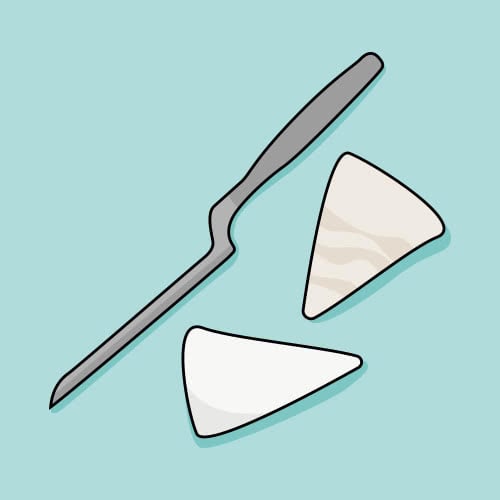
Slim Blade Cheese Knife
A slim blade knife features very little surface area to prevent soft cheeses from sticking to the blade. It is typically offset from the handle to provide room for the user’s hand to keep the knuckles from hitting the board.
- Features: Thin narrow blade, sharp edge, raided handle
- Cheese Hardness: Soft to Semi-Hard
- Ideal Cheeses: Camembert, Boursault

Flat Cheese Knife
A flat cheese knife, or a chisel knife, is used to cut slices off of aged cheeses by holding the blade vertically over the cheese and pushing downward. You can then use the sharp end to cut the pieces down even further.
- Features: Wide flat paddle-like blade, sharp bottom edge
- Cheese Hardness: Semi-Soft to Semi-Hard
- Ideal Cheeses: Provolone, Swiss, Gruyere, Asiago

Narrow Plane Knife
A narrow plane cheese knife, also known as a trapezium knife, is made for cutting cheese as well as chipping away at the block. It is similar to the flat cheese knife but tends to be more rectangular in shape and features two sharp sides as opposed to one.
- Features: Narrow blade, both the short edge and long edge are sharp
- Cheese Hardness: Semi-Soft to Hard
- Ideal Cheeses: Gouda, Cheddar, Jarlsberg

Cheddar Cheese Knife
A cheddar knife, also known as a mini cleaver, cheddar cleaver, or semi-hard cheese knife, is made to cut hard cheeses. The wide blade and cleaver shape allow the cutter to use force and balance to push down and cut slices. The placement of the handle keeps your knuckles from hitting the board.
- Features: Wide rectangular blade, sharp long edge, ergonomic handle
- Cheese Hardness: Semi-Hard to Hard
- Ideal Cheeses: Cheddar, Gruyere, Colby, Fontina
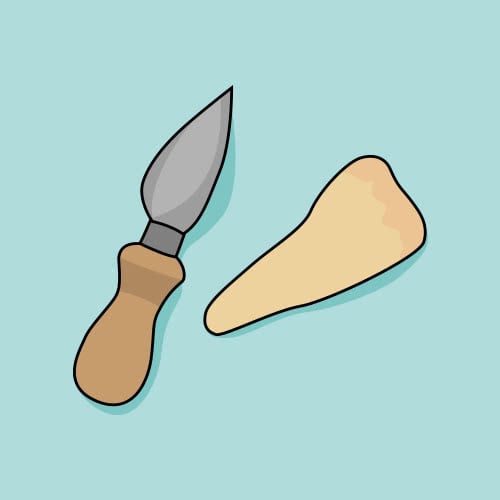
Parmesan Knife
A parmesan cheese knife features a pointed edge made for breaking off chunks of hard and dry cheeses like Parmesan. It also has a sharp edge to cut rinds open. Parmesan knives come in two different styles: the bell cheese knife which will have an arrowhead-shaped blade, and the compact cheese knife which has a blade that resembles a shark tooth. Both styles perform the same function when cutting cheese.
- Features: Sharp-pointed tip, triangular stubby blade, sharp long edge
- Cheese Hardness: Hard
- Ideal Cheeses: Parmesan, Castelmagno, Grana Padano
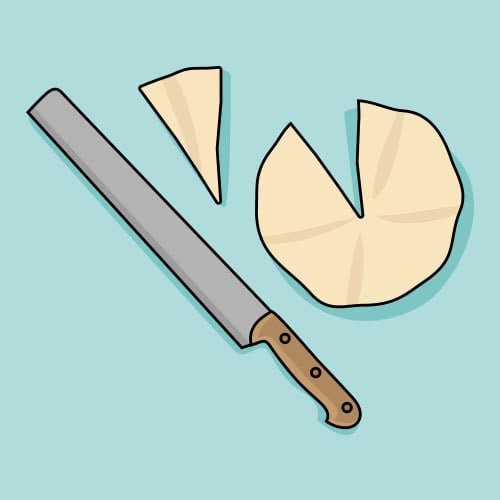
Hard Cheese Knife
Hard cheese knives are typically one of the largest you will find. They are made for pressing downward and cutting through a whole wheel or wedge of aged hard cheese to form smaller portions. You will often find hard cheese knives with handles on either end to allow for even pressure distribution.
- Features: Long straight blade, sharp edge, one or two handles
- Cheese Hardness: Hard
- Ideal Cheeses: Asiago, Extra Mature Cheddar, Provolone, Comte
Other Cheese Tools
Some cheese knife kits will come with additional tools to help cut and serve cheeses. Here are some of the more common cheese tools you may encounter:

Cheese Wire
A cheese wire, or bow knife, is made for cutting those delicate soft cheeses without crushing them or spreading them too far. They are usually found in a bow shape or attached to a cheese board that had an indent for the wire. The wire would be lowered down gently through the cheese, leaving a clean slice behind.
- Features: Metal wire, bow or handle
- Cheese Hardness: Soft to Semi-Soft
- Ideal Cheeses: Fresh Mozzarella, Ricotta, Robiola
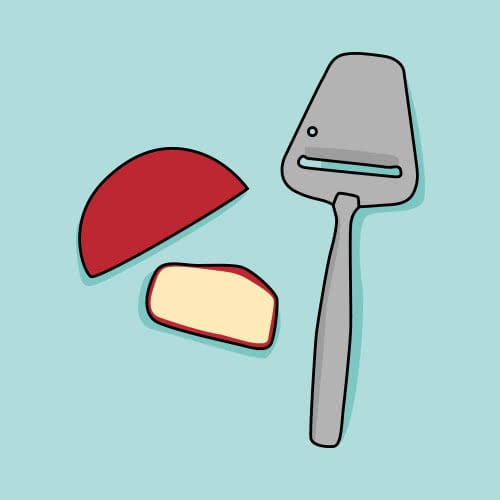
Cheese Plane
A cheese plane was made for achieving thinly sliced pieces of cheese. To slice the cheese, pass the plane along the top or side of the cheese. The slice will then settle on the top of the plane’s spatula-like structure, making it easy to plate or serve.
- Features: Spatula-like paddle with a sharp-edged slit
- Cheese Hardness: Semi-Soft to Semi-Hard
- Ideal Cheeses: Fontina, Havarti, Muenster

Cheese Rind Cutter
A rind cutter features a pointed tip that is made to score the rind of a hard cheese, making it easier to open. This is essential when serving stinky cheese varieties, which typically are rind-washed cheese. To use a rind cutter, pierce the rind at one edge and drag it neatly across the surface of the rind.
- Features: Pointed downward tip, sharp edge
- Cheese Hardness: Semi-Hard to Hard
- Ideal Cheeses: Parmigiano Reggiano, Grana Padano

Cheese Grater
A cheese grater is excellent for creating shreds of cheese. They will typically have razors on more than one side of it to produce different size shreds when a block of cheese is pressed down against the grooves. You can also use a cheese grater to shred a variety of other foods.
- Features: Several sharp razors on flat plane
- Cheese Hardness: Semi-Hard to Hard
- Ideal Cheeses: Parmesan, Romano

Cheese Fork
A cheese fork is helpful on a cheese board for picking up cut pieces of cheese for plating. It can also be used to break up blocks of aged cheese into smaller chunks as well.
- Features: Two pointed prongs
- Cheese Hardness: Semi-Soft to Hard
- Ideal Cheeses: Feta, Cheddar, Provolone, Gouda, Parmesan
How to Cut Cheese
Now that you know which type of knife to pair with your cheese, it is important to know how to properly cut those cheeses, whether they be in wheels, wedges, or blocks.
Soft Cheese Wedges
When cutting into a wedge of soft cheese, you'll want to cut slices along the long edge of the cheese, creating a long strip. It is considered poor etiquette to cut the tip or nose of the cheese wedge because that is considered to be the piece with the most flavor. It is also incorrect to dig out the gooey center of a soft cheese, such as brie.
Hard Cheese Wedges
For semi-hard to hard cheeses wedges, you'll want to cut these wedges along the width edge until you reach halfway up the wedge. The top half of the wedge is then cut along the length edge.
Blue Cheese Wedges
To cut a wedge of blue cheese, pinpoint the center of the bottom edge and cut in a radial pattern to achieve triangular cheese pieces.
Blocks
When cutting a block of cheese, first cut it in half to create two rectangular portions, then cut along the width of the portions to create slices. Slices can then be cut diagonally into triangles if you prefer.
Logs
Cut cheese logs by slicing down the length of the log to create cheese discs.
Wheels
To cut a wheel of cheese, you can first cut the wheel in half to make two manageable pieces. Then cut in a radial pattern to create cheese triangles. If you choose not to cut the wheel in half, locate the center of the cheese wheel and cut out from that point like spokes on a wheel.
Whether you’re catering a cocktail hour or a holiday gathering with an eye-catching cheese board, it is essential to pair your cheeses with the right knife to provide the best experience at your event.
 Printable Version
Printable Version


